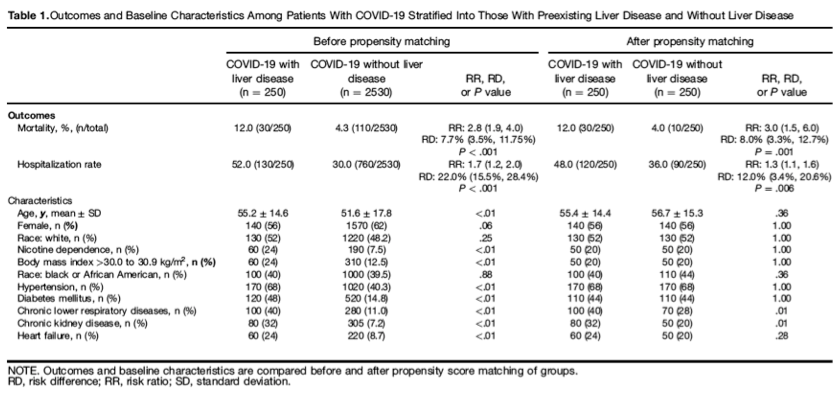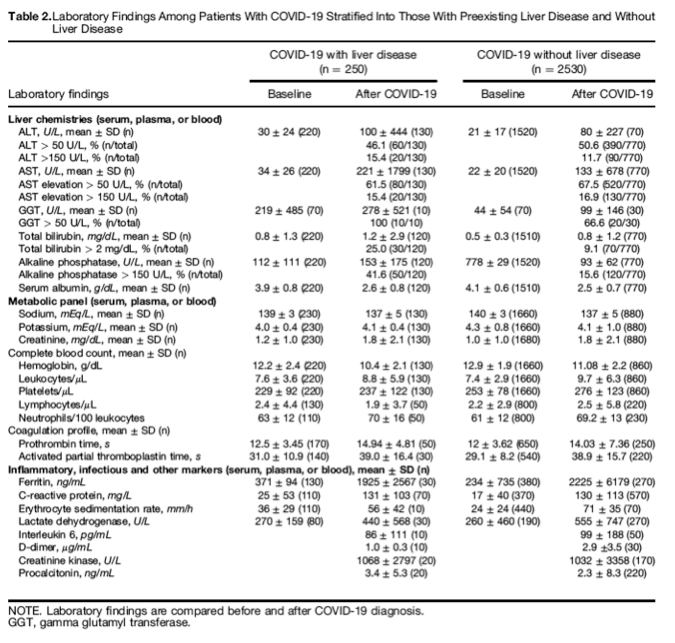| |
|
Clinical Characteristics and Outcomes of Coronavirus Disease 2019 Among Patients With Preexisting Liver Disease in the United States: A Multicenter Research Network Study
|
| |
| |
Download the PDF here
Gastroenterology May 2020- Shailendra Singh1,2 and Ahmad Khan3
1West Virginia University, West Virginia University Health Sciences Center, Charleston Division, Charleston, West Virginia;
2Charleston Area Medical Center Health System, Charleston, West Virginia; and 3Department of Medicine, West Virginia
University Health Sciences Center Charleston Division, Charleston, West Virginia
We compared the outcomes of patients with preexisting liver disease and without liver disease in a large and diverse cohort of 2780 patients with COVID-19 in the United States. Elevation in liver chemistry test levels was seen in the vast majority of patients, suggesting possible liver injury in COVID-19. We found that patients with preexisting liver disease were at increased risk for mortality (RR, 2.8; 95% CI, 1.9-4.0; P <.001) compared to patients without liver disease, and the relative risk was markedly higher in patients with cirrhosis (RR, 4.6; 95% CI, 2.6-8.3; P < .001).
---------------------------------
Comparison of mortality risk in patients with cirrhosis and COVID-19 compared with patients with cirrhosis alone and COVID-19 alone: multicentre matched cohort - (08/25/20)
Hepatitis B and C Virus Considerations in COVID-19 - (08/25/20)
SARS-CoV-2 and the Liver: Considerations in Hepatitis B and Hepatitis C Infections - (08/25/20)
--------------------------------------
Coronavirus disease 2019 (COVID-19) caused by severe acute respiratory syndrome coronavirus 2 (SARS-CoV-2) has emerged as a global public health crisis. Liver injury has been reported during the COVID-19 disease progression.
However, previous studies did not examine in detail the interaction of preexisting liver disease and COVID-19.
Therefore, we aimed to study the impact of preexisting liver disease on outcomes in a large cohort of patients with COVID-19 in the United States.
Methods
A real-time search and analysis were performed for patients (≥10 years age) diagnosed with COVID-19 by using the TriNetX (Cambridge, MA) Research Network with COVID-19-specific diagnosis and terminology recommended by the World Health Organization and Centers for Disease Control and Prevention. TriNetX provided real-time access to the electronic medical records of more than 49 million patients from 37 health care organizations.
Identified patients with COVID-19 were then stratified into 2 groups based on the presence (LD) or absence (non-LD) of preexisting liver disease. The LD group consisted of patients with a diagnosis of chronic liver disease, cirrhosis, or related complications either at the time of diagnosis of COVID-19 or any time before that.
The outcomes studied were mortality, hospitalization, and laboratory findings in the time window up to 30 days from the diagnosis of COVID-19. All statistical analyses were performed with TriNetX. TriNetX obfuscates patient counts to safeguard protected health information by rounding patient counts in analyses up to the nearest 10.
Details of the data source, search criteria, diagnosis, study variables, statistical analysis, and limitations of the methodology are available in the Supplementary Methods.
Results
We identified a total of 2780 patients with COVID-19 across 34 health care organizations in the United States. There were 250 (9%) patients with preexisting liver disease included in the LD group, and the remaining 2530 were included in the non-LD group. Among the LD group patients, 50 (1.8%) were also diagnosed with cirrhosis. LD group patients were older than those in the non-LD group (55.2 ± 14.6 vs 51.6 ± 17.8 years; P < .01). LD group patients had substantially higher comorbidities, and a large proportion had hypertension (68%) or diabetes (48%). Fatty liver disease or nonalcoholic steatohepatitis (42%) was the most common among LD group patients. Therefore, we performed (1:1) propensity score matching for body mass index, hypertension, and diabetes in addition to age, race, and nicotine use. The groups were relatively balanced after propensity matching (n = 250 in each group) (Table 1 and Supplementary Figure 1).

The mean values of alanine aminotransferase (ALT) and aspartate aminotransferase (AST) were elevated from baseline after COVID-19 in both the LD (ALT, 100 ± 444 U/L; AST, 221 ± 1799 U/L) and the non-LD group (ALT, 80 ± 227 U/L; AST, 133 ± 678U/L). ALT elevations (>50 U/L) were seen in 46.1% in the LD group and 50.6% in the non-LD group (Table 2 and Supplementary Figure 2). Similarly, elevations in mean values of gamma-glutamyl transferase, alkaline phosphatase, and total bilirubin were also seen. Concentrations of ferritin, C-reactive protein, lactate dehydrogenase, interleukin 6, creatine kinase, and D-dimer were also elevated in both groups (Table 2).
Patients in the LD group had a significantly higher risk of mortality (risk ratio [RR], 2.8; 95% confidence interval [CI], 1.9-4.0; P < .001), and the risk remained high even after the propensity matching of the 2 groups (RR, 3.0; 95% CI, 1.5-6.0; P = .001). In the subgroup analysis of the LD group, patients with cirrhosis had an even higher relative risk of mortality compared to patients in the non-LD group (RR, 4.6; 95% CI, 2.6-8.3; P < .001). Similarly, the risk of hospitalization was higher in the LD group before and after the matching of cohorts (Table 1).

Discussion
We compared the outcomes of patients with preexisting liver disease and without liver disease in a large and diverse cohort of 2780 patients with COVID-19 in the United States. Elevation in liver chemistry test levels was seen in the vast majority of patients, suggesting possible liver injury in COVID-19. We found that patients with preexisting liver disease were at increased risk for mortality (RR, 2.8; 95% CI, 1.9-4.0; P <.001) compared to patients without liver disease, and the relative risk was markedly higher in patients with cirrhosis (RR, 4.6; 95% CI, 2.6-8.3; P < .001).
Our findings are similar to those reported for other comorbidities, such as hypertension, diabetes, or cardiovascular disease, yielding poor outcomes.
Many comorbidities overlap in patients or have a similar profile; a large proportion of patients in the preexisting liver disease group had fatty liver disease along with diabetes and hypertension. Therefore, we performed propensity matching of the groups and still found a higher risk for mortality and hospitalization in patients with preexisting liver disease.
The possible reasons for poor outcomes among COVID-19 with preexisting liver disease need further investigation; however, it appears to be an interplay of local liver injury and systemic disturbances. SARS-CoV-2 binds to the angiotensin-converting enzyme 2 (ACE2) receptor to gain entry and damage the target organ.
The expression of angiotensin-converting enzyme 2 receptors has been suggested in both liver and bile duct cells.
Previous studies have reported abnormalities in transaminases in 14%-53% of patients with COVID-19.
We also noticed elevations in liver chemistry test results from baseline values, suggesting possible liver injury from SARS-CoV-2. However, we cannot rule out medications or other possible etiologies for these abnormalities and are unable to specify a pattern of liver injury. Hypoxia often seen in COVID-19 can induce diminished cellular activity and high-level oxygen free radicals, resulting in liver injury and organ failure.
Patients with COVID-19 with preexisting liver dysfunction, especially with cirrhosis, are theoretically more susceptible to poor outcomes from these direct injuries to liver. Moreover, the immune deficiency and accompanying persistent systemic inflammation reflected by the activated circulating immune cells and increased serum levels of proinflammatory cytokines that occurs in patients with advanced liver disease can predispose them to uncontrollable proinflammatory cytokine production.
Many patients with cirrhosis can also have underlying hepatopulmonary syndrome, portopulmonary hypertension, or hepatic hydrothorax, which can increase the risk of respiratory failure in itself.
In conclusion, liver injury can be seen in the majority of patients with COVID-19. However, patients with preexisting liver disease, notably cirrhosis, are at higher risk for hospitalizations and mortality. Early isolation, intensive surveillance, and timely diagnosis are essential in these patients. Further research identifying interventions to reduce poor outcomes in high-risk patients with COVID-19 is needed.
| |
| |
| |
|
|
|